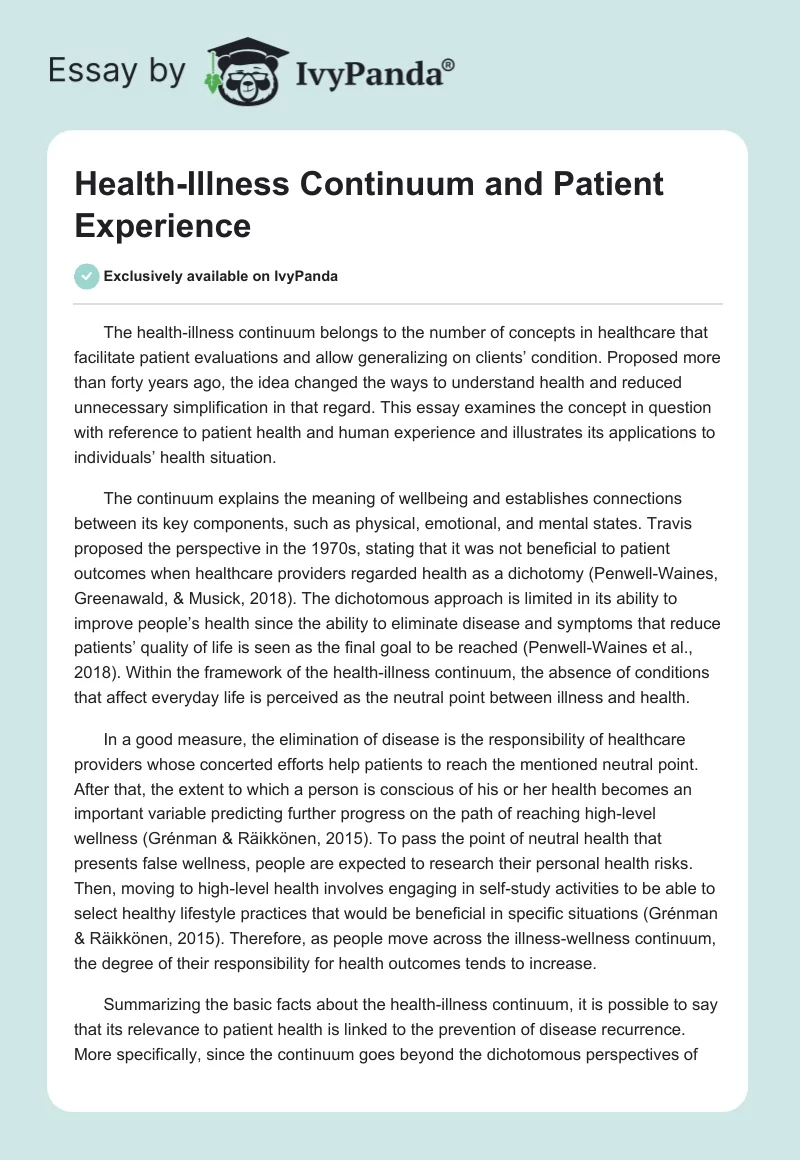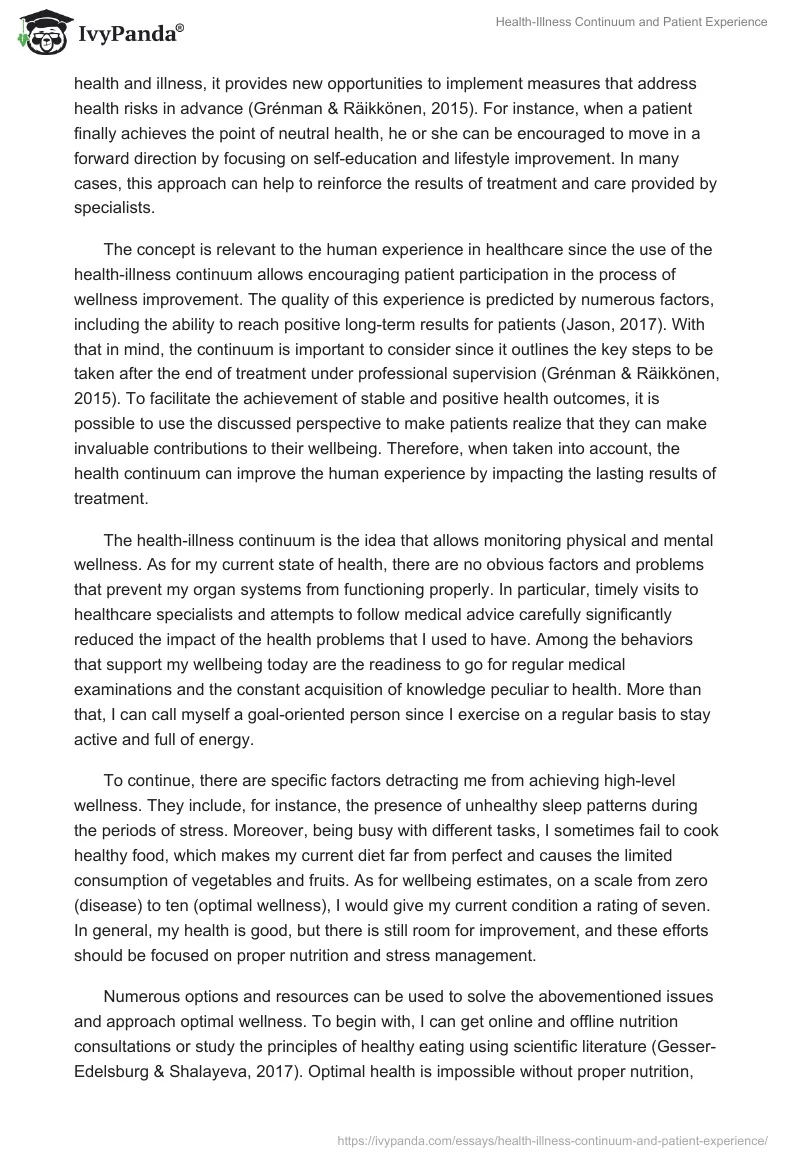The health-illness continuum belongs to the number of concepts in healthcare that facilitate patient evaluations and allow generalizing on clients’ condition. Proposed more than forty years ago, the idea changed the ways to understand health and reduced unnecessary simplification in that regard. This essay examines the concept in question with reference to patient health and human experience and illustrates its applications to individuals’ health situation.
The continuum explains the meaning of wellbeing and establishes connections between its key components, such as physical, emotional, and mental states. Travis proposed the perspective in the 1970s, stating that it was not beneficial to patient outcomes when healthcare providers regarded health as a dichotomy (Penwell-Waines, Greenawald, & Musick, 2018). The dichotomous approach is limited in its ability to improve people’s health since the ability to eliminate disease and symptoms that reduce patients’ quality of life is seen as the final goal to be reached (Penwell-Waines et al., 2018). Within the framework of the health-illness continuum, the absence of conditions that affect everyday life is perceived as the neutral point between illness and health.
In a good measure, the elimination of disease is the responsibility of healthcare providers whose concerted efforts help patients to reach the mentioned neutral point. After that, the extent to which a person is conscious of his or her health becomes an important variable predicting further progress on the path of reaching high-level wellness (Grénman & Räikkönen, 2015). To pass the point of neutral health that presents false wellness, people are expected to research their personal health risks. Then, moving to high-level health involves engaging in self-study activities to be able to select healthy lifestyle practices that would be beneficial in specific situations (Grénman & Räikkönen, 2015). Therefore, as people move across the illness-wellness continuum, the degree of their responsibility for health outcomes tends to increase.
Summarizing the basic facts about the health-illness continuum, it is possible to say that its relevance to patient health is linked to the prevention of disease recurrence. More specifically, since the continuum goes beyond the dichotomous perspectives of health and illness, it provides new opportunities to implement measures that address health risks in advance (Grénman & Räikkönen, 2015). For instance, when a patient finally achieves the point of neutral health, he or she can be encouraged to move in a forward direction by focusing on self-education and lifestyle improvement. In many cases, this approach can help to reinforce the results of treatment and care provided by specialists.
The concept is relevant to the human experience in healthcare since the use of the health-illness continuum allows encouraging patient participation in the process of wellness improvement. The quality of this experience is predicted by numerous factors, including the ability to reach positive long-term results for patients (Jason, 2017). With that in mind, the continuum is important to consider since it outlines the key steps to be taken after the end of treatment under professional supervision (Grénman & Räikkönen, 2015). To facilitate the achievement of stable and positive health outcomes, it is possible to use the discussed perspective to make patients realize that they can make invaluable contributions to their wellbeing. Therefore, when taken into account, the health continuum can improve the human experience by impacting the lasting results of treatment.
The health-illness continuum is the idea that allows monitoring physical and mental wellness. As for my current state of health, there are no obvious factors and problems that prevent my organ systems from functioning properly. In particular, timely visits to healthcare specialists and attempts to follow medical advice carefully significantly reduced the impact of the health problems that I used to have. Among the behaviors that support my wellbeing today are the readiness to go for regular medical examinations and the constant acquisition of knowledge peculiar to health. More than that, I can call myself a goal-oriented person since I exercise on a regular basis to stay active and full of energy.
To continue, there are specific factors detracting me from achieving high-level wellness. They include, for instance, the presence of unhealthy sleep patterns during the periods of stress. Moreover, being busy with different tasks, I sometimes fail to cook healthy food, which makes my current diet far from perfect and causes the limited consumption of vegetables and fruits. As for wellbeing estimates, on a scale from zero (disease) to ten (optimal wellness), I would give my current condition a rating of seven. In general, my health is good, but there is still room for improvement, and these efforts should be focused on proper nutrition and stress management.
Numerous options and resources can be used to solve the abovementioned issues and approach optimal wellness. To begin with, I can get online and offline nutrition consultations or study the principles of healthy eating using scientific literature (Gesser-Edelsburg & Shalayeva, 2017). Optimal health is impossible without proper nutrition, and this is why the mentioned options are so important (Grénman & Räikkönen, 2015). Such resources will increase my chances to achieve wellness by helping me to understand and address some nutrition mistakes that can give rise to health issues gradually.
To move toward high-level wellness, it is possible to seek the assistance of local mental health professionals or even yoga teachers. I experience stress from time to time, and delving into well-known approaches to stress management can help me to reduce its negative impact on my emotional and physical condition, including occasional sleeping problems. Learning new stress reduction techniques will cause improvements in both physical and mental health, thus giving me more energy to live a wellness lifestyle on a daily basis.
To sum it up, the health-illness continuum is an important perspective that reduces the oversimplification of wellness in healthcare. In nursing practice, this idea should be considered due to its potential effects on long-term treatment outcomes and patients’ awareness of the principles of healthy living. Personally, I am in good health, but my dietary habits and stress coping strategies need to be altered to continue moving toward wellness.
References
Gesser-Edelsburg, A., & Shalayeva, S. (2017). Internet as a source of long-term and real-time professional, psychological, and nutritional treatment: A qualitative case study among former Israeli Soviet Union immigrants. Journal of Medical Internet Research, 19(2), e33.
Grénman, M., & Räikkönen, J. (2015). Well-being and wellness tourism – same, but different? Conceptual discussions and empirical evidence. The Finnish Journal of Tourism Research, 11(1), 7-25.
Jason, A. (2017). The patchwork perspective: A new view for patient experience. Patient Experience Journal, 4(3), 1-3.
Penwell-Waines, L., Greenawald, M., & Musick, D. (2018). A professional well-being continuum: Broadening the burnout conversation. Southern Medical Journal, 111(10), 634-635.


